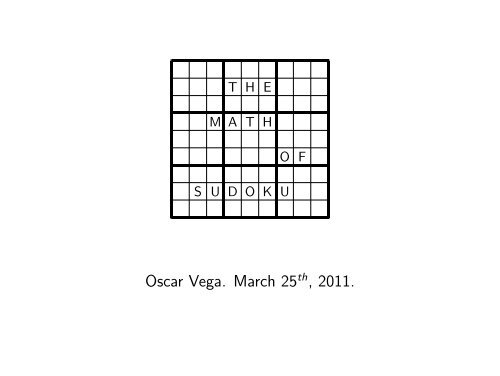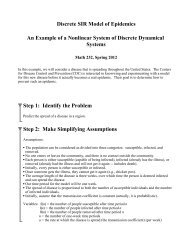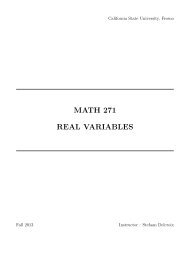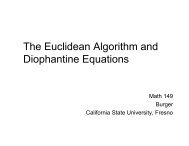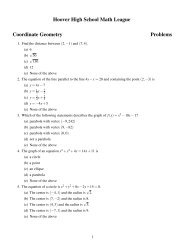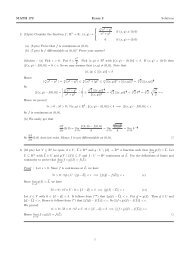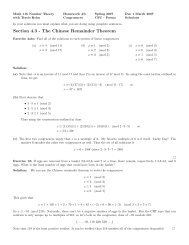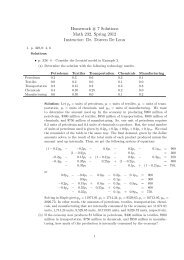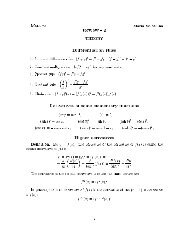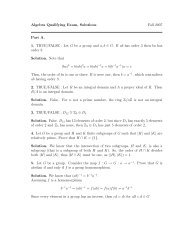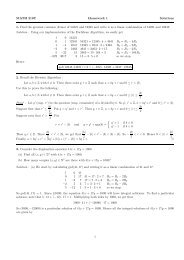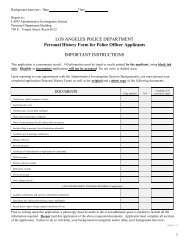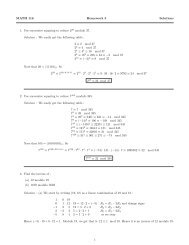The Math of Sudoku
The Math of Sudoku
The Math of Sudoku
- No tags were found...
Create successful ePaper yourself
Turn your PDF publications into a flip-book with our unique Google optimized e-Paper software.
T H EM A T HS U D O K UO FOscar Vega. March 25 th , 2011.
<strong>The</strong> GameA <strong>Sudoku</strong> board is a 9 × 9 table filled with nine different symbols, usually1, 2, · · · , 9, that has been partitioned into nine 3 × 3 blocks such that:each symbol appears exactly once in each row,each symbol appears exactly once in each column,each symbol appears exactly once in each block.<strong>The</strong> game consists in completing a sudoku board from the few entriesgiven.5 3 76 1 9 5 39 8 68 6 34 8 3 17 2 66 2 84 1 9 58 7 9
<strong>The</strong> GameA <strong>Sudoku</strong> board is a 9 × 9 table filled with nine different symbols, usually1, 2, · · · , 9, that has been partitioned into nine 3 × 3 blocks such that:each symbol appears exactly once in each row,each symbol appears exactly once in each column,each symbol appears exactly once in each block.<strong>The</strong> game consists in completing a sudoku board from the few entriesgiven.5 3 4 6 7 8 9 1 26 7 2 1 9 5 3 4 81 9 8 3 4 2 5 6 78 5 9 7 6 1 4 2 34 2 6 8 5 3 7 9 17 1 3 9 2 4 8 5 69 6 1 5 3 7 2 8 42 8 7 4 1 9 6 3 53 4 5 2 8 6 1 7 9
Sudo What?<strong>The</strong> name is derived from ‘suji wa dokushin ni kagiru’, which is theJapanese for ‘the digits must remain single’.It is known that this game (essentially the same) was already knownin France in the 1800’s.
Sudo-History<strong>The</strong> modern version <strong>of</strong> <strong>Sudoku</strong> is an American invention (notJapanese). <strong>The</strong> author is unknown, but there is evidence it wasHoward Garns.First published by Dell Puzzle Magazine in 1979 under the nameNumber Place.Taken by the Japanese puzzle company Nikoli in the mid-80’s. Thatis when the name <strong>Sudoku</strong> was originated.In 2005, Felgenhauer and Jarvis proved that there are6,670,903,752,021,072,936,960 <strong>Sudoku</strong> boards. Russell and Jarvisproved that there are 5,472,730,538 essentially different boards.
Pop Culture: Cool, Awesome... X-treme!!!
Pop Culture: Silly, Funny,.... WTH?
<strong>Math</strong> Game?People say that sudoku is a math game because numbers are used to play.But any set <strong>of</strong> nine distinct symbols can be used to play.5 3 76 1 9 5 39 8 68 6 34 8 3 17 2 66 2 84 1 9 58 7 9−→E C GF A I E CI H FH F CD H C AG D FFB HD A I EH G I
<strong>Math</strong> Game?People say that sudoku is a math game because numbers are used to play.But any set <strong>of</strong> nine distinct symbols can be used to play.5 3 76 1 9 5 39 8 68 6 34 8 3 17 2 66 2 84 1 9 58 7 9−→♦ ℵ ∫♠♣ ∞ ♦ ℵ∞ ⊗♣H ♣∫ℵ∂ ⊗ ℵ♠ ∂ ♣♣♥ ⊗∂ ∫ ∞ ♦⊗ ♠ ∞Having to use numbers to fill the cells does not make it a math game.<strong>The</strong>n, what does?
Logic GameIn order to succeed solving <strong>Sudoku</strong> puzzles one has to use logic!Can the techniques used to play sudoku be seen as techniques used topro<strong>of</strong> mathematical theorems?I might be pushing it here, let us see a few examples.
Direct Pro<strong>of</strong>5 3 76 1 9 5 39 8 68 6 34 8 3 17 2 66 2 84 1 9 58 7 9−→5 3 76 1 9 5 39 8 68 6 34 8 3 17 2 66 2 88 4 1 9 58 7 9
Forcing Chains (Pro<strong>of</strong> by Contradiction)276756−→7 6 756573535573535
Forcing Chains (Pro<strong>of</strong> by Contradiction)276756−→7 656573535573535
Forcing Chains (Pro<strong>of</strong> by Contradiction)276756−→7 6 5573535573535
Forcing Chains (Pro<strong>of</strong> by Contradiction)276756−→7 6 557353557335
Forcing Chains (Pro<strong>of</strong> by Contradiction)276756−→7 6 5573535357 5
Forcing Chains (Pro<strong>of</strong> by Contradiction)276756−→7 6 557353537 5CONTRADICTION!!!
Forcing Chains (Pro<strong>of</strong> by Cases)2315 3 2 558355778−→15 3 2 5583355778
Forcing Chains (Pro<strong>of</strong> by Cases)2315 3 2 558355778−→15 3 2 5583 55778
Forcing Chains (Pro<strong>of</strong> by Cases)2315 3 2 558355778−→15 3 2 5583 5778
Forcing Chains (Pro<strong>of</strong> by Cases)2315 3 2 558355778−→3 5715 3 2 558 8
Forcing Chains (Pro<strong>of</strong> by Cases)2315 3 2 558355778−→3 5715 3 2 55 8So, 5 cannot be in the square with options 1, 3, 5 (A4).
Forcing Chains (Pro<strong>of</strong> by Cases)2315 3 2 558355778−→15 3 2 5582355778
Forcing Chains (Pro<strong>of</strong> by Cases)2315 3 2 558355778−→15 3 5582355778So, 5 cannot be in the square with options 1, 3, 5 (A4). In either case!!
Many-to-oneWe can create many other sudoku boards out <strong>of</strong> this one by:rotating it,interchanging ‘stacks’,interchanging ‘bands’,interchanging columns in a stack,interchanging rows in a band,relabeling <strong>of</strong> the digits.
IsomorphismsBoards that can be connected to each other using (finitely many <strong>of</strong> ) thetricks described in the previous slide are said to be essentially the same.How many boards can we get out <strong>of</strong> a single given board?Starting with one <strong>Sudoku</strong> puzzle, a daily calendar <strong>of</strong> <strong>Sudoku</strong> puzzlescan be produced... enough for the entire next century! 1 .<strong>The</strong>re are 6,670,903,752,021,072,936,960 distinct <strong>Sudoku</strong> boards 2 .<strong>The</strong>re are 5,472,730,538 essentially different boards 3 .1 Bartlett & Langville. An Integer Programming Model for the <strong>Sudoku</strong>Model. <strong>The</strong> Journal <strong>of</strong> Online <strong>Math</strong>ematics and Its Applications, Vol. 8 (2008)2 Felgenhauer & Jarvis, <strong>Math</strong>ematics <strong>of</strong> <strong>Sudoku</strong> I (2006)3 Russel & Jarvis. <strong>Math</strong>ematics <strong>of</strong> <strong>Sudoku</strong> II (2006)
MinimalityQ. What is the minimum number <strong>of</strong> ‘givens’ in a <strong>Sudoku</strong> board that areneeded to have unique solution?A. Unknown.<strong>The</strong> minimum number known is 17. Gordon Royle has a collection <strong>of</strong>49151 distinct <strong>Sudoku</strong> configurations with 17 entries athttp://mapleta.maths.uwa.edu.au/∼gordon/sudokumin.phpGary McGuire is conducting a search for a 16-given <strong>Sudoku</strong> boardwith unique solution. He developed a program, called CHECKER forthis purpose. It seems that the program requires about 300,000 years(on a one-core computer equipped with CPU, Intel(R) Xeon(R)E5520 @ 2.27GHz) to finish the job.http://www.math.ie/checker.html
UniquenessA well-defined <strong>Sudoku</strong> board must have a unique solution. This can beused to solve <strong>Sudoku</strong> boards.Hence, the following situation is impossible!!5 1 6 8 2 7 9 4 32 7 8 3 9 4 6 1 53 4 9 6 1 5 8 7 29 8 3 7 4 3 7 2 1 5 64 6 5 1 8 9 2 3 71 2 3 7 5 3 7 6 4 8 98 9 2 7 4 3 5 6 16 3 4 9 5 1 7 2 87 5 1 2 6 8 3 9 4
<strong>The</strong> graph <strong>of</strong> a <strong>Sudoku</strong> boardHerzberg and Ram Murty associated the following graph to a <strong>Sudoku</strong>board.vertices = cells.edge between two vertices = two cells are ‘buddies’.BBBB B B B C B B B BB B BB B BBBB
Coloring a <strong>Sudoku</strong> boardHerzberg and Ram Murty proved 4 that the coloring <strong>of</strong> the graph describedin the previous slide is related to the uniqueness <strong>of</strong> solutions for <strong>Sudoku</strong>boards.<strong>The</strong> coloring <strong>of</strong> the vertices is obvious: <strong>The</strong> nine digits used represent 9distinct colors.Note that solving a <strong>Sudoku</strong> puzzle is nothing but (the mathematical task<strong>of</strong>) extending a partial vertex coloring to a valid 9-coloring <strong>of</strong> the entiregraph.<strong>The</strong>orem (Herzberg & Ram Murty)<strong>The</strong> chromatic number <strong>of</strong> a <strong>Sudoku</strong> puzzle is 9.4 <strong>Sudoku</strong> Squares and Chromatic Polynomials. Notices <strong>of</strong> the AMS. Vol. 54,Number 6 (2007)
More theorems<strong>The</strong>orem (Herzberg & Ram Murty)Let G be a graph with chromatic number C(G) and P be a partial coloring<strong>of</strong> G using only C(G) − 2 colors. If P can be completed to a total propercoloring <strong>of</strong> G, then there are at least two ways <strong>of</strong> extending the coloring.CorollaryLet n be distinct numbers in a given <strong>Sudoku</strong> puzzle. If n ≤ 7 then thesolution <strong>of</strong> the given <strong>Sudoku</strong> puzzle is not unique.In a related note: the following theorem is due to Sander 5<strong>The</strong>orem<strong>The</strong> eigenvalues <strong>of</strong> the adjacency matrix <strong>of</strong> the <strong>Sudoku</strong> graph are integers.5 <strong>Sudoku</strong> graphs are integral. <strong>The</strong> electronic journal <strong>of</strong> combinatorics 16(2009), #N25
Latin squaresIntroduced and studied by Leonhard Euler in the 1700’s.A Latin square <strong>of</strong> order n is an n × n table filled with n differentsymbols in such a way that:each symbol appears exactly once in each row, and each column.Examples: a Latin square <strong>of</strong> order 4 with entries {♠, ♥, ♦, ♣} andone <strong>of</strong> order 5 with entries {a, b, c, d, e} :♠ ♥ ♦ ♣♥ ♦ ♣ ♠♦ ♣ ♠ ♥♣ ♠ ♥ ♦a b c d eb c e a dc e d b ad a b e ce d a c b
Latin squares <strong>of</strong> order 9Let us look at a Latin square <strong>of</strong> order 9 with entries {1, 2, 3, 4, 5, 6, 7, 8,9} :8 3 2 5 9 1 6 7 41 8 5 7 4 6 3 9 25 7 1 2 6 4 9 8 34 9 6 3 8 7 2 5 12 6 7 9 5 3 4 1 89 4 3 8 1 2 7 6 57 1 4 6 3 8 5 2 93 2 9 1 7 5 8 4 66 5 8 4 2 9 1 3 7Reminded you <strong>of</strong> something?
Gerechte designsIntroduced by the German statistician W.U. Behrens in 1956.A gerechte design is an n × n table filled with n different symbols andpartitioned into n regions, each containing n small squares <strong>of</strong> the grid,in such a way that :each symbol occurs exactly once in each row, each column,and eachregion.Example: two gerechte designs <strong>of</strong> order 9:
T H A N KY O U


